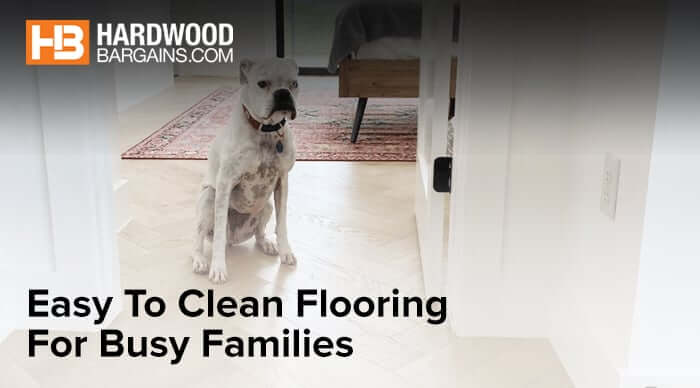When selecting flooring for high-traffic areas, durability is key. Whether you're outfitting a busy hallway, kitchen, or living room, the right hardwood flooring can make all the difference.
Not only do you need flooring that will stand the test of time, but it must also maintain its beauty despite constant foot traffic. Engineered hardwood flooring offers an excellent solution for such areas. This article will explore the best types of durable hardwood flooring for high-traffic zones, installation tips, and maintenance advice to ensure long-lasting results in your home.
1. Why High-Traffic Areas Need Durable Flooring
High-traffic areas in your home are the spaces that receive the most footfall: hallways, living rooms, kitchens, and entryways. These areas are subject to wear and tear from shoes, pets, furniture, spills, and daily activities. Over time, poorly chosen flooring can show signs of damage like scratches, dents, fading, and warping.
Durable flooring ensures that your investment lasts longer, providing you with beautiful floors that retain their integrity despite constant use. Hardwood is naturally resilient, but when selecting flooring for high-traffic spaces, it's important to choose species and finishes that offer the best performance under pressure. Additionally, engineered hardwood flooring provides superior durability due to its layered construction, making it an ideal choice for areas with heavy foot traffic.
2. Best Hardwood Species for High-Traffic Areas
Not all hardwoods are created equal. Some species are naturally more durable and better suited for high-traffic areas. When selecting the right hardwood for these spaces, consider both hardness and resilience. Here are some of the best hardwood species for high-traffic areas:
Oak
Oak is one of the most popular hardwoods due to its durability and classic appeal. It has a high Janka hardness rating, meaning it can withstand heavy foot traffic and resist scratches and dents. White oak, in particular, is known for its toughness and moisture resistance, making it a great option for kitchens and entryways.
Maple
Maple is another dense and durable wood, often used in commercial settings due to its resistance to wear and tear. Its fine grain gives it a smooth texture, and its light color complements a variety of interior designs. While it is somewhat softer than oak, it still holds up well in high-traffic areas when properly maintained.
Hickory
Hickory is one of the hardest domestic hardwoods available. It has a rugged texture and varying grain patterns, which help camouflage minor imperfections that can occur in busy spaces. Its toughness makes it ideal for high-traffic areas like living rooms and hallways, where durability is a top priority.
Cherry & Walnut
Though not as hard as oak or maple, cherry and walnut can still provide durable hardwood flooring for high-traffic areas, especially if the look you're going for is more refined and elegant. Cherry offers a rich reddish-brown color that deepens over time, while walnut has a deep, dark tone that can add a sophisticated touch to any room. These species are best suited for areas with moderate traffic, but when properly finished and maintained, they can perform well.
Tips for Choosing the Right Wood Species:
Choose hardwoods with higher Janka hardness ratings for more durability.
Consider how the wood’s natural characteristics (e.g., grain, color) will complement your home’s décor.
For areas prone to moisture or humidity, like kitchens and bathrooms, select species with greater moisture resistance, such as white oak.
3. Benefits of Durable Hardwood Flooring
Durable hardwood flooring isn’t just about withstanding heavy use. It also offers a range of benefits that can elevate the overall look and feel of your home, especially in high-traffic areas.
Longevity and Resilience
The primary benefit of durable hardwood flooring is its longevity. High-quality hardwood can last decades, often outlasting other types of flooring such as carpet, vinyl, or laminate. With proper care, hardwood flooring will maintain its beauty over time, even in areas with significant foot traffic.
Aesthetic Appeal
Hardwood floors are timeless and versatile. No matter the style of your home, hardwood can be stained or finished to match any aesthetic. Whether you prefer a rustic farmhouse look, a sleek modern style, or something in between, durable hardwood flooring provides a sophisticated, elegant look that enhances any space.
Easy Maintenance
Hardwood floors are relatively easy to maintain, especially when compared to carpet or other porous flooring materials. Regular sweeping or vacuuming and occasional mopping are usually enough to keep the floors looking their best. Additionally, scratches and scuffs can often be buffed out or refinished, restoring the floor to its original beauty.
4. How to Install Hardwood Flooring in High-Traffic Areas
Installing hardwood flooring in high-traffic areas requires careful attention to detail to ensure the flooring holds up well over time. Here are some important steps to follow when installing hardwood floors:
Professional vs. DIY Installation
While DIY installation can save you money, it’s crucial to weigh the risks. Improper installation can lead to issues like uneven flooring, gaps, or buckling over time. If you're not experienced with floor installation, it’s often worth investing in a professional installer who can ensure the job is done right.
Subfloor Preparation
Before laying hardwood flooring, ensure the subfloor is clean, dry, and level. Any imperfections in the subfloor can lead to uneven surfaces or damage to the hardwood flooring. In high-traffic areas, it's especially important to check for moisture issues or weak spots, as these can cause problems with the hardwood over time.
Installation Tips:
Acclimate the hardwood before installation by letting it sit in the room for at least 48 hours to adjust to the temperature and humidity.
Use the right underlayment to provide cushioning and improve sound insulation.
Leave a small gap between the edges of the floor and the walls to allow for expansion and contraction.
5. Maintenance Tips for Long-Lasting Hardwood Flooring
To ensure your durable hardwood floors continue to perform well in high-traffic areas, regular maintenance is essential. Here are some key tips for keeping your hardwood floors in top condition:
Regular Cleaning
Sweep or vacuum your hardwood floors regularly to prevent dirt and debris from scratching the surface. It’s also important to mop with a damp cloth (not soaking wet) to avoid water damage. Choose a cleaner specifically designed for hardwood floors to avoid harsh chemicals that can damage the finish.
Protecting Floors from Scratches
To prevent scratches, place rugs or mats in high-traffic zones and use felt pads on the bottoms of furniture legs. Consider applying a protective finish or topcoat that helps resist scratches and scuffs.
Refinishing Hardwood Floors
Over time, high-traffic areas may show signs of wear, but the good news is that hardwood floors can often be refinished. Sanding the floors and applying a fresh coat of finish can restore their beauty and remove superficial damage, making your floors look like new again.
6. Cost Considerations: Is Durable Hardwood Worth the Investment?
Durable hardwood flooring is an investment, especially when selecting it for high-traffic areas. While the initial cost may be higher than other flooring types, it offers significant long-term value.
Initial Cost vs. Long-Term Value
The upfront cost of hardwood flooring can vary depending on the species, finish, and installation method. Engineered hardwood, which has a layered structure for added stability, tends to be more affordable than solid hardwood but still provides excellent durability. While hardwood floors may be more expensive than alternatives like vinyl or laminate, they can last decades with proper maintenance, making them a smart investment for homeowners looking for longevity.
How Hardwood Flooring Saves Money Over Time
Durable hardwood floors can save you money in the long run. With proper care, they won’t need to be replaced every few years, as is the case with carpet or laminate flooring. Additionally, refinishing your hardwood floors can restore them to their original condition, further extending their lifespan.
7. Sustainable Options for High-Traffic Areas
In addition to durability, sustainability is an increasingly important factor for many homeowners when selecting flooring. Fortunately, several sustainable hardwood options provide the durability needed for high-traffic areas while minimizing environmental impact.
Eco-Friendly Hardwood Choices:
Reclaimed Wood: Recycled from old buildings or barns, reclaimed wood has a unique character and helps reduce deforestation.
FSC-Certified Wood: The Forest Stewardship Council (FSC) certifies wood that comes from sustainably managed forests, ensuring minimal environmental impact.
Bamboo: While not technically hardwood, bamboo is a highly durable and sustainable option for high-traffic areas.
Choosing sustainable hardwood not only contributes to a healthier planet but also ensures that your flooring investment is responsibly sourced.
When selecting durable hardwood flooring for high-traffic areas, it's essential to choose a wood species that can withstand the wear and tear of daily life while still adding beauty to your home. Engineered hardwood offers an ideal combination of durability, aesthetics, and easy maintenance for spaces with heavy foot traffic. By selecting the right species, following proper installation techniques, and maintaining your floors regularly, you can enjoy floors that remain beautiful and functional for years to come.
Explore our wide range of engineered hardwood flooring options at Hardwood Bargains today, and transform your high-traffic areas with flooring that lasts.





